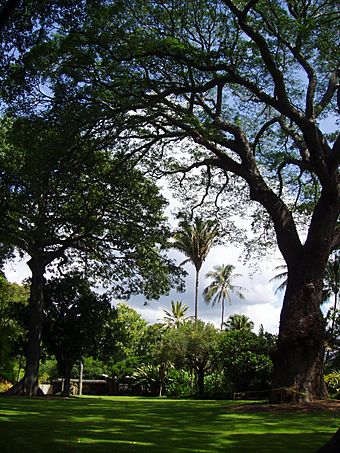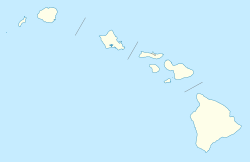Foster Botanical Garden facts for kids
Quick facts for kids |
|
|
Foster Botanical Garden
|
|

General view of the garden
|
|
| Location | 50 N. Vineyard Blvd., Honolulu, Hawaii |
|---|---|
| Built | 1853 |
| Architect | Harold L. Lyon |
| NRHP reference No. | 93000377 |
| Added to NRHP | May 13, 1993 |
Foster Botanical Garden is one of five public botanical gardens on Oahu, Hawaii. It covers about 13.5 acres and is located in Honolulu, near Chinatown. The garden is in a busy city area, close to schools and different places of worship.
This garden is the oldest botanical garden in Hawaii. It is also listed on the National Register of Historic Places, which means it's an important historical site.
Contents
History of Foster Botanical Garden
In 1853, Queen Kalama leased about 4.6 acres of land to William Hillebrand. He was a German doctor and botanist. Hillebrand built his home there and planted many trees. He also brought new plants, deer, and mynah birds to Hawaii. Many of the large trees you see today on the Upper Terrace were planted by him.
After 20 years, Hillebrand went back to Germany. In 1884, Thomas R. Foster and his wife, Mary E. Foster, bought the property. They continued to develop the garden around their home. When Mary Foster passed away in 1930, she left the land and her home to the City and County of Honolulu. She asked the city to always keep the gardens as a public park called Foster Park. At that time, the gardens were about 5.5 acres.
Dr. Harold Lyon became the first director of Foster Garden. He brought thousands of new plants and trees to Hawaii. He also started the garden's famous collection of orchids. From 1957 to 1989, Paul Weissich was the director. He made Foster Garden bigger, reaching 14 acres. He also created four more garden sites on Oahu Island. Together, these five gardens form the Honolulu Botanical Gardens system, covering 650 acres. This system has the largest and most diverse collection of tropical plants in the United States.
The garden even inspired a line in Joni Mitchell's 1970 song "Big Yellow Taxi". She sang, "Took all the trees, put 'em in a tree museum / Then charge people a dollar and a half just to see 'em.".
What You Can See at Foster Botanical Garden Today
Today, Foster Botanical Garden has several interesting areas:
- Upper Terrace: This is the oldest part of the garden.
- Middle Terraces: Here you can find many palm trees, aroids, heliconias, and gingers.
- Economic Garden: This section features plants used for herbs, spices, dyes, and even some poisons.
- Prehistoric Glen: Planted in 1965, this area has very old types of plants.
- Lyon Orchid Garden: A beautiful collection of orchids.
- Hybrid Orchid Display: More stunning orchids to see.
The garden is also home to many special trees. One notable tree is a Sacred Fig. This tree is a descendant of the famous Bodhi tree that Buddha sat under. A young tree from the original Bodhi tree was given to Mary Foster in 1913. Overall, the garden has 25 of the roughly 100 trees on Oahu that are considered exceptional.
You can also find several memorials and sculptures in the garden:
- A small copy of the Daibutsu (Giant Buddha statue) from Kamakura, Japan. It celebrates 100 years of Japanese people moving to Hawaii.
- A memorial stone marks the site of the first Japanese language school on Oahu. This is where a shell exploded during the Japanese attack in 1941.
- The 1977 abstract ceramic sculpture 'Sandwich Isle' by artist Bob Flint.
- The 1974 sculpture Tree by Charles W. Watson.
Images for kids
See also
 In Spanish: Jardín botánico Foster para niños
In Spanish: Jardín botánico Foster para niños



